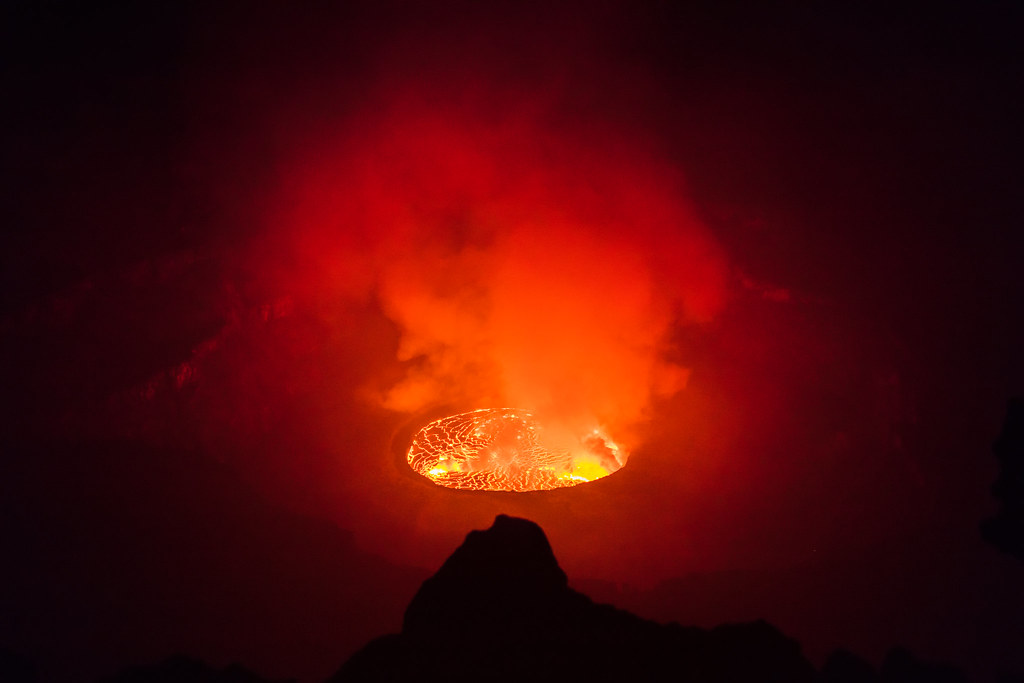Mount Nyiragongo Volcano Congo Eruption – May 2021
On the evening of May 22, 2021, Mount Nyiragongo—one of the world’s most active and dangerous volcanoes—erupted violently near Goma, a major city in the Democratic Republic of Congo (DRC). The eruption sent rivers of molten lava cascading down its steep slopes toward populated areas, causing widespread panic, destruction, and displacement. Situated in the Virunga Mountains, close to the Rwandan border, Nyiragongo’s eruption was a stark reminder of the immense power and unpredictability of the Earth’s natural forces.
The Eruption Unfolds
The eruption began unexpectedly around 7:00 PM local time, when the night sky over Goma glowed red, signaling that Nyiragongo’s lava lake had breached. The volcano’s steep crater walls allowed lava to flow rapidly downhill toward the city and nearby villages. Within hours, the molten rivers had reached the outskirts of Goma, a city of nearly two million residents located just 12 kilometers from the volcano.
The lava destroyed hundreds of homes, roads, and critical infrastructure. By dawn, the fiery streams had stopped just short of Goma International Airport, narrowly sparing the city center. However, surrounding areas such as Buhene, Majengo, and Kibati suffered extensive damage.
Tremors and aftershocks continued for several days following the eruption, with seismologists warning of potential secondary eruptions or underground magma movement beneath Lake Kivu—one of Africa’s Great Lakes, known for containing vast quantities of dissolved methane and carbon dioxide.
Humanitarian Impact
The eruption claimed at least 32 lives, according to local and UN reports, and displaced more than 30,000 people. Many fled on foot toward the Rwandan border or to safer areas west of Goma. For days, families camped in open fields, churches, and schools as aid organizations worked to provide shelter, food, and medical assistance.
Electricity outages and water shortages worsened the humanitarian situation, while toxic gas emissions and fissures opened by seismic activity created additional hazards. Children were among the most affected, with several reported missing in the chaotic evacuations.
The UN Refugee Agency (UNHCR), Red Cross, and Médecins Sans Frontières (MSF) were among the first to respond, coordinating emergency relief and reunification efforts for separated families.
Scientific Background – The Power of Nyiragongo
Mount Nyiragongo, standing at 3,470 meters (11,384 feet), is part of the Virunga volcanic chain in eastern Congo. What makes this volcano particularly dangerous is its unusually fluid lava, composed of low-silica basalt that allows it to flow at speeds up to 100 kilometers per hour on steep slopes—making evacuation extremely difficult once an eruption begins.
The volcano’s lava lake, one of the largest and most active in the world, has fascinated scientists for decades. Before the 2021 eruption, its activity had been closely monitored, but the sudden breach of the crater wall came with little warning.
Nyiragongo’s eruptions are historically devastating. The last major event in January 2002 destroyed nearly 15% of Goma, killing about 250 people and displacing over 120,000. The 2021 eruption, though less extensive, revived fears of a future disaster involving Lake Kivu’s gas reserves, which could trigger a potentially catastrophic release known as a “limnic eruption.”
Regional Response and Recovery
Following the eruption, the Congolese government declared a state of emergency in North Kivu province and temporarily evacuated parts of Goma due to continued seismic activity. Scientists from the Observatoire Volcanologique de Goma (OVG) and international partners worked tirelessly to assess risks and monitor the volcano’s behavior.
By early June 2021, tremors had decreased, allowing many displaced residents to return home. However, rebuilding efforts faced significant challenges, as hundreds of families lost property and livelihoods. Local and international aid agencies helped reconstruct damaged infrastructure and resettle those who lost their homes.
In Rwanda, the neighboring city of Gisenyi also felt tremors and hosted thousands of Congolese refugees during the eruption’s peak. Rwanda’s authorities and humanitarian organizations provided temporary shelter and emergency supplies, demonstrating cross-border solidarity in the face of disaster.
Lessons and Ongoing Monitoring
The 2021 Nyiragongo eruption underscored the urgent need for improved volcanic monitoring and early-warning systems in the region. The Virunga region is one of the world’s most volcanically active zones, yet its dense population and limited infrastructure make it especially vulnerable.
Since the eruption, the OVG has received additional international support to enhance seismic sensors and communication systems. Efforts are ongoing to strengthen community preparedness, establish evacuation routes, and educate residents about volcanic risks.
Mount Nyiragongo continues to rumble periodically, with visible smoke and occasional minor activity observed since late 2022. While tourism to nearby Virunga National Park and Goma has resumed, authorities maintain strict monitoring to ensure visitor and local safety.
The Enduring Legacy of Nyiragongo
The 2021 eruption of Mount Nyiragongo remains a powerful symbol of nature’s force and the resilience of the people living in its shadow. Goma’s residents, though scarred by past eruptions, continue to rebuild their city with determination and courage. The eruption also reignited global awareness of the delicate balance between human life and the Earth’s restless geology in one of Africa’s most beautiful yet volatile regions.
Standing today over the cooled black lava fields, one can still sense the immense energy that shaped them—a humbling reminder that Mount Nyiragongo, though quiet for now, remains very much alive.





